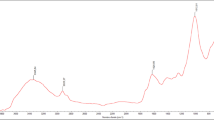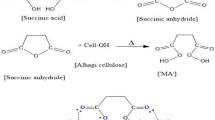Abstract
Biosorption is a viable and environmentally friendly process to remove pollutants and species of commercial interest. Biological materials are employed as adsorbents for the retention, removal, or recovery of potentially toxic metals from aqueous matrices. Hexavalent chromium is a potential contaminant commonly used in galvanoplasty and exhibits concerning effects on humans and the environment. The present work used in natura lettuce root (LR) and nanomodified lettuce root (LR-NP) for Cr(VI) adsorption from water medium. The nanomodification was performed by coprecipitation of magnetite nanoparticles on LR. All materials were morphologically and chemically characterized. The conditions used in removing Cr(VI) were determined by evaluating the pH at the point of zero charge (pHPZC = 5.96 and 6.50 for LR and LR-NP, respectively), pH, kinetics, and sorption capacity in batch procedures. The maximum sorption capacity of these materials was reached at pH 1.0 and 30 min of adsorbent-adsorbate contact time. The pseudo-second-order kinetic equation provided the best adjustments with r2 0.9982 and 0.9812 for LR and LR-NP, respectively. Experimental sorption capacity (Qexp) results were 4.51 ± 0.04 mg/g, 2.48 ± 0.57 mg/g, and 3.84 ± 0.08 mg/g for LR, NP, and LR-NP, respectively, at a 10 g/L adsorbent dose. Six isothermal models (Langmuir, Freundlich, Sips, Temkin, DR, and Hill) fit the experimental data to describe the adsorption process. Freundlich best fit the experimental data suggesting physisorption. Despite showing slightly lower Qexp than LR, LR-NP provides a feasible manner to remove the Cr(VI)-containing biosorbent from the medium after sorption given its magnetic characteristic.








Similar content being viewed by others
Availability of data and materials
All data generated or analyzed during this study are included in this published article. Extra Data are available from the authors (elma.carrilho@gmail.com) upon reasonable request.
References
Abilio TE, Soares BC, José JC, Milani PA, Labuto G, Carrilho ENVM (2021) Hexavalent chromium removal from water: adsorption properties of in natura and magnetic nanomodified sugarcane bagasse. Environ Sci Pollut Res 28:24816–24829
Akhter MF, Omelon CR, Gordon RA, Moser D, Macfie SM (2014) Localization and chemical speciation of cadmium in the roots of barley and lettuce. Environ Exp Bot 100:10–19
Appel C, Ma LQ, Rhue RD, Kennelley E (2003) Point of zero charge determination in soils and minerals via traditional methods and detection of electroacoustic mobility. Geoderma 113:77–93
Arif Z, Sethy NK, Mishra PK, Verma B (2020) Development of eco-friendly, self-cleaning, antibacterial membrane for the elimination of chromium (VI) from tannery wastewater. Int J Environ Sci Technol 17:4265–4280
Ayawei N, Ebelegi AN, Wankasi D (2017) Modelling and interpretation of adsorption isotherms. J Chem 2017:1–11
Babu DJ, King P, Kumar YP (2019) Optimization of Cu (II) biosorption onto sea urchin test using response surface methodology and artificial neural networks. Int J Environ Sci Te 16:1885–1896
Bakatula EN, Richard D, Neculita CM, Zagury GJ (2018) Determination of point of zero charge of natural organic materials. Environ Sci Pollut Res 25(8):7823–7833
Beretta GZ, Abilio TE, Gabriel L, Labuto G, Carrilho ENVM (2021) Competitive adsorption of Cr(III) and Cr(VI) by sugarcane bagasse magnetic nanocomposite in water matrix: a pH study. Ambiente: Gestão e Desenvolvimento 1(1): 47–54
Binod P, Satyanagalakshmi K, Sindhu R, Janu KU, Sukumaran RK, Pandey A (2012) Short duration microwave assisted pretreatment enhances the enzymatic saccharification and fermentable sugar yield from sugarcane bagasse. Renew Energy 37:109–116
Blaney L (2007) Magnetite (Fe3O4): Properties, synthesis, and applications. The Lehigh Review 5(15):33–81
Brito SMO, Cordeiro JLC, Ramalho LC, Oliveira JFR (2019) Eriochrome black adsorption on yellow passion fruit peel (Passiflora edulis f. Flavicarpa) treated with sodium hydroxide and nitric acid: study of adsorption isotherms, kinetic models and thermodynamic parameters. SN Appl Sci 1:1226
Cardona DS, Debs KB, Lemos SG, Vitale G, Nassar NN, Carrilho ENVM, Semensatto D, Labuto G (2019) A comparison study of cleanup techniques for oil spill treatment using magnetic nanomaterials. J Environ Manage 242:362–371
Carvalho JTT, Milani PA, Consonni JL, Labuto G, Carrilho ENVM (2021) Nanomodified sugarcane bagasse biosorbent: synthesis, characterization, and application for Cu(II) removal from aqueous medium. Environ Sci Pollut Res 28:24744–24755
Cid H, Ortiz C, Pizarro J, Moreno-Piraján (2020) Effect of copper (II) biosorption over light metal cation desorption in the surface of macrocystis pyrifera biomass. J Environ Chem Eng 8(3):103729
Conceição JDC, Ramos VHS, Jesus ED, Silva AS, Costa AWMC (2014) Biosorption of Cr(VI) from aqueous solutions using chemically modified okra powder. J Basic Appl Sci 10:73–79
Debs KB, Cardona DS, Silva HDT, Nassar N, Carrilho ENVM, Haddad PS, Labuto G (2019) Oil spill cleanup employing magnetite nanoparticles and yeast-based magnetic bionanocomposite. J Environ Manage 230:405–412
Dhankhar R, Hooda A (2011) Fungal biosorption – an alternative to meet the challenges of heavy metal pollution in aqueous solutions. Environ Technol 32:467–491
Fernández-Nieves A, Richter C, Nieves FJ (1998) Point of zero charge estimation for a TiO2/water interface. Progr Colloid Polym Sci 110:21–24
Foo KY, Hameed BH (2010) Insights into the modeling of adsorption isotherm systems. Chem Eng J 156:2–10
Furlan FR, Silva LGM, Morgado AF, Souza AAU, Souza SMAGU (2010) Removal of reactive dyes from aqueous solutions using combined coagulation/flocculation and adsorption on activated carbon. Resour Conserv Recycl 54:283–290
Gabriel L, Soares BC, Beretta GZ, Abilio TE, Labuto G, Carrilho ENVM (2021) Effect of pH on the simultaneous sorption of Cr(III) and Cr(VI) by magnetic nanomodified lettuce roots in aqueous medium. Ambiente: Gestão e Desenvolvimento 1(1):19–25
Gadd GM (2009) Biosorption: critical review of scientific rationale, environmental importance and significance for pollution treatment. J Chem Technol Biotechnol 84:13–28
Giles CH, MacEwan TH, Nakhwa SN, Smith D (1960) Studies in adsorption. Part XI. a system of classification of solution adsorption isotherms, and its use in diagnosis of adsorption mechanisms and in measurement of specific surface areas of solids. J Chem Soc 111:3973–3993
Giles CH, Smith D, Huitsom A (1974) A general treatment and classification of the solute adsorption isotherm. I Theoretical J Colloid Interface Sci 47:755–776
Gonzalez M, Araujo G, Pelizaro C, Menezes E, Lemos S, De Souza G, Nogueira A (2008) Coconut coir as biosorbent for Cr(VI) removal from laboratory wastewater. J Hazard Mater 159:252–256
Ho YS (2006) Review of second-order models for adsorption systems. J Hazard Mater 136(3):681–689
Ho YS, Mckay G (2000) The kinetics of sorption of divalent metal ions onto sphagnum moss peat. Water Res 34(3):735–742
Hu J, Lo IMC, Chen G (2004) Removal of Cr(VI) by magnetite nanoparticle. Water Sci Technol 50(12):139–146
Jobby R, Jha P, Kumar A, Desai YN (2018) Biosorption and biotransformation of hexavalent chromium [Cr(VI)]: a comprehensive review. Chemosphere 207:255–266
José JC, Debs KB, Labuto G, Carrilho ENVM (2019) Synthesis, characterization and application of yeast-based magnetic bionanocomposite for the removal of Cu(II) from water. Chem Eng Commun 206(11):1581–1591
Kanagaraj G, Elango L (2019) Chromium and fluoride contamination in groundwater around leather tanning industries in southern India: Implications from stable isotopic ratio δ53Cr/δ52Cr, geochemical and geostatistical modelling. Chemosphere 220:943–953
Kratochvil D, Pimentel P, Volesky B (1998) Removal of trivalent and hexavalent chromium by seaweed biosorbent. Environ Sci Technol 32:2693–2698
Labuto G, Cardona DS, Debs KB, Imamura AR, Bezerra KCH, Carrilho ENVM, Haddad PS (2018) Low cost agroindustrial biomasses and ferromagnetic bionanocomposites to cleanup textile effluents. Desalin Water Treat 12:80–89
Li J, Ma J, Guo Q, Zhang S, Han H, Zhang S, Han P (2020) Adsorption of hexavalent chromium using modified walnut shell from solution. Water Sci Technol In press
Limousin G, Gaudet JP, Charlet L, Szenknect S, Barthes V, Krimissa M (2007) Sorption isotherms: a review on physical bases, modeling and measurement. App Geochem 22:249–275
Liu C, Jin RN, Ouyang XK, Wang YG (2017) Adsorption behavior of carboxylated cellulose nanocrystal–polyethyleneimine composite for removal of Cr(VI) ions. Appl Surf Sci 408:77–87
Milani PA, Consonni JL, Labuto G, Carrilho ENVM (2018a) Agricultural solid waste for sorption of metal ions, part II: competitive assessment in multielemental solution and lake water. Environ Sci Pollut Res 25(36):35906–35914
Milani PA, Debs KB, Labuto G, Carrilho ENVM (2018b) Agricultural solid waste for sorption of metal ions: part I – characterization and use of lettuce roots and sugarcane bagasse for Cu(II), Fe(II), Zn(II), and Mn(II) sorption from aqueous medium. Environ Sci Pollut Res 25(36):35895–35905
Mothé CG, De Miranda IC (2009) Characterization of sugarcane and coconut fibers by thermal analysis and FTIR. J Therm Anal Calorim 97:661–665
Mou B (2008) Lettuce In: Prohens J., Nuez F. Vegetables I. Handbook of Plant Breeding. Springer, New York
Omer AM, Khalifa RE, Hu Z, Zhang H, Liu C, Ouyang XK (2019) Fabrication of tetraethylenepentamine functionalized alginate beads for adsorptive removal of Cr (VI) from aqueous solutions. Int J Biol Macromol 125:1221–1231
Panneerselvam P, Morad N, Tan K (2011) Magnetic nanoparticle (Fe3O4) impregnated onto tea waste for the removal of nickel(II) from aqueous solution. J Hazard Mater 186:160–168
Raganati F, Alfe M, Gargiulo V, Chirone R, Ammendola P (2019) Kinetic study and breakthrough analysis of the hybrid physical/chemical CO2 adsorption/desorption behavior of a magnetite-based sorbent. Chem Eng J 372:526–535
Rossi AD, Rigon MR, Zaparoli M, Braido RD, Colla LM, Dotto GL, Piccin JS (2018) Chromium (VI) biosorption by Saccharomyces cerevisiae subjected to chemical and thermal treatments. Environ Sci Pollut Res 25(19):19179–19186
Saadi R, Saadi Z, Fazaeli R, Fard NE (2015) Monolayer and multilayer adsorption isotherm models for sorption from aqueous media. Korean J Chem Eng 32(5):787–799
Santos VC, De Souza JV, Tarley CR, Caetano J, Dragunski DC (2011) Copper ions adsorption from aqueous medium using the biosorbent sugarcane bagasse in natura and chemically modified. Water Air Soil Pollut 216:351–359
Schwantes D, Gonçalves AC Jr, Miola AJ, Coelho GF, Santos MG, Leismann EAV (2015) Removal of Cu (II) and Zn (II) from water with natural adsorbents from cassava agroindustry residues. Acta Sci-Technol 37(3):409–417
Silverstein RM, Webster FX, Kiemle DJ (2012) Spectrometric identification of organic compounds, 8th edn. Wiley, New Jersey
Volesky B (2004) Sorption and Biosorption. BV-Sorbex Inc, St.Lambert, Quebec
Yao Q, Zhang H, WU J, Shao L, He P (2010) Biosorption of Cr(III) from aqueous solution by freeze-dried activated sludge: equilibrium, kinetic and thermodynamic studies. Front Environ Sci Eng China 4(3):286–294
Zheng J-C, Feng H-M, Lam MH-W, Lam PK-S, Ding Y-W, Yu H-Q (2009) Removal of Cu(II) in aqueous media by biosorption using water hyacinth roots as a biosorbent material. J Hazard Mater 171:780–785
Funding
This work was supported by Fundação de Amparo à Pesquisa do Estado de São Paulo (FAPESP) (2016/06271–4 and 2019/08335–8) and Conselho Nacional de Desenvolvimento Científico e Tecnológico (CNPq) (163205/2019–1 and 166783/2019–6).
Author information
Authors and Affiliations
Contributions
EC and GL postulated and supervised the study. BCS and EC planned the experiment. BCS and TEA obtained the data, and EC, GL, and JCJ carried out the data analysis and interpretation. GL performed the adjustment of all experimental data to the isothermal models applied. BCS, JCJ, and TEA prepared the first draft, and EC and GL thoroughly revised the manuscript. EC, GL, and BCS read and approved the final manuscript.
Corresponding author
Ethics declarations
Ethical approval
Not applicable.
Consent to participate
Not applicable.
Consent to publish
Not applicable.
Competing interests
The authors declare no competing interests.
Additional information
Communicated by Tito Roberto Cadaval Jr.
Publisher's Note
Springer Nature remains neutral with regard to jurisdictional claims in published maps and institutional affiliations.
Supplementary Information
Below is the link to the electronic supplementary material.
Rights and permissions
About this article
Cite this article
Soares, B.C., Abilio, T.E., José, J.C. et al. Removal of Cr(VI) from water by in natura and magnetic nanomodified hydroponic lettuce roots. Environ Sci Pollut Res 30, 8822–8834 (2023). https://doi.org/10.1007/s11356-022-21755-0
Received:
Accepted:
Published:
Issue Date:
DOI: https://doi.org/10.1007/s11356-022-21755-0




